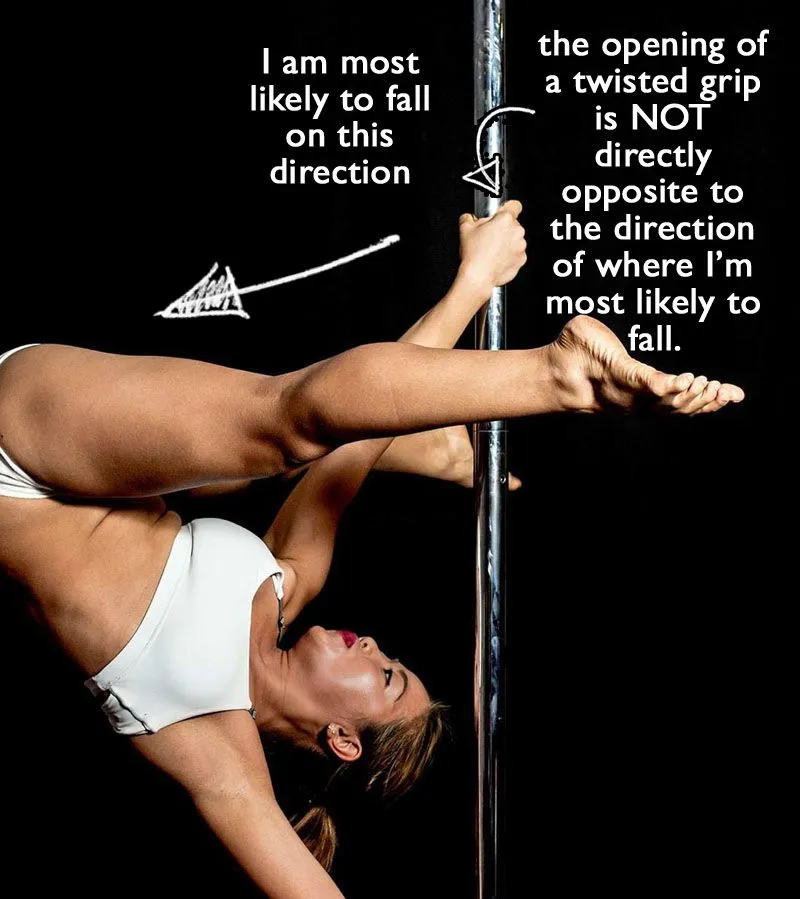This will be my first post about pole dancing. As I have mentioned in my introduction post, I enjoy pole dancing and I just started it (and fitness in general) two years ago. Photos are screenshots (hence the very poor quality) from my entry for @steemitgottalent sponsored by @sunnylife, @immarojas, @maverickinvictus, @ankarlie, @allerie00 and @sorenkierkegaard. I’m new to steemit and I figured this can be a good start. My short video showed interesting gripping and contact techniques that are essential to pull off different pole tricks and transitions. Either you’re into pole fitness or not, I’m sure you will find it interesting how seemingly “hard” things become easier with proper techniques.
Pole dancing requires upper body strength. However, upper body strength is not a guarantee to be able to execute pole tricks at first few tries without knowledge of the proper gripping and points of contact. My Friends who are not into pole fitness often overestimate my upper body strength. To tell you honestly, in my current physique, I can only do two decent pull ups. A lot of tricks in pole become easier with proper grip and if you keep in mind the areas that should be in contact with the pole. Let’s get to my first photo so you’ll know what I’m talking about.
The Split Grip Straddle

This is a straddle pose using a split grip. This grip has two goals: To keep me from falling down and to keep my body away from the pole. It may seem like there's a lot of pressure on my lower hand but it’s not really what it looks like. My weight is distributed in both hands. My upper hand (right hand) pulls my body upward, while my bottom hand (left hand) pushes the pole to prevent me from sliding down and keep my body away from the pole.

Notice how my bottom hand (left hand) is at about 45 degrees from the pole. This angle gives me a nice distance from the pole to keep my bottom arm (left arm) fully engaged and extended. If I keep an angle too close to the pole, I will slip downward. If angle is too large, most of my strength will push me away from the pole. Less fraction of my force will push my body upward and support my other hand (right hand). My right arm is not strong enough to carry all my weight.
Next
The Jade Split

“Look at me mom, No hands!”...Awesome, right? With no hands on the pole, points of contact are of essence. Understanding the positioning of my body will make you realize there’s no super human talent right there. With the right technique, it’s almost impossible to fall and break my neck.
Let us first look closely at my left hand which is holding my right foot. This is the most important hand placement to nail a jade split. My left hand does two important things: open my splits and tighten the contact of my inner thigh to the pole and my stomach. Twisting my torso towards the pole is a compromise for my lack of flexibility to nail a perfect split. I am just pulling my leg down and in towards my left shoulder to really give it a tight squeeze as I sandwich the pole between my thigh and stomach.
Twisted Hand Grip Ayesha

I love this super powerful pose. With the proper and secure grip, I am able to hold this trick longer. When I first got in to pole fitness and saw my instructor do this, I said to myself, "Meh, I'll never be able to do that".

This twisted grip was the sweet secret sauce that made my Ayesha magic possible. Though it looks (and feels) awkward, this is for me, a very secure grip to pull the pole and keep me from falling to my death. You may notice that it looks like the split grip straddle but upside-down. Just like the split grip, distance of left and right hand is important. The bottom hand (left hand) keeps my body away from the pole while pushing it upward. Weight is evenly distributed in both hands. Balance is kept by spreading legs evenly on both sides.
Forearm Grip Air Walk

Forearm grip is a grip that holds the pole with your hands while leaning one side (co-linear with the elbow) of your forearm, in parallel with the pole. With forearm grip, climbing the pole becomes easier (compared to other gripping techniques). Increased contact surface to the pole is the key secret of the forearm grip wizardry. Its purpose is to keep my body away from the pole. With forearm parallel with the pole, contact area is greater and greater force is effected with minimal pressure felt on points of contact.
In pole, l learned that understanding your weakness and knowing the right execution techniques makes seemingly difficult things doable. It also taught me that small details can make a huge difference, so it’s important to pay attention to them. This learning doesn’t end within the walls of our pole studio but I’m taking it with me to all other aspects of my life. Personally, it made me become more objective when faced with any challenges. I am always reminded to tell myself: “There should be a way on how to attack this problem. The worst case is that it’s hard, but not impossible”
Did this post made you appreciate pole as a sport and as an art? I really hope so. Until next time!
And Oh by the way, Here's the video (Music is titled Madness by Ruelle):
